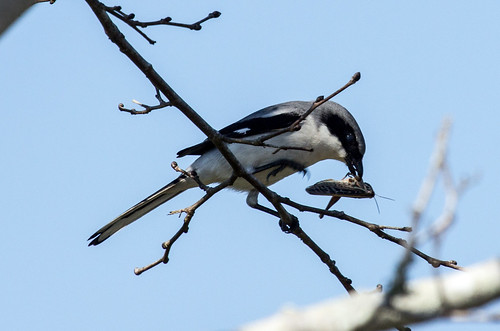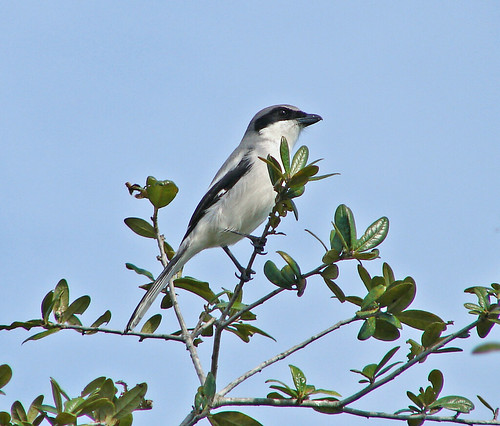 |
| Loggerhead Shrike |
When I bird in Florida, I’m ever scanning fence posts and
power lines in hopes of seeing Loggerhead Shrikes.
Shrikes are predacious
songbirds, but that’s not very exceptional—so are chickadees, robins, and
bluebirds, the insects and worms they eat being very much animals. Shrikes feed
on small lizards, birds, and mammals as well as insects, but so do some crows,
ravens, and even large flycatchers. The difference is that shrikes eat meat
almost exclusively, with physical and behavioral adaptations unique among
songbirds. The hooked beak tip and sharp notch near the tip help grab and sever
the spinal cord of small vertebrates. When a shrike bites off more than it can
chew in one meal, so to speak, it can impale whole prey or parts on thorns or
barbed wire, or wedge it into the fork of a branch, both for easier killing and
for longer-term storage. This habit led to the family nickname, “butcherbirds.”
The proportionally large head of all shrikes is particularly highlighted in the
Loggerhead Shrike’s name, a synonym for “blockhead.” Of the 30 or so species in
the family, only the Loggerhead is entirely restricted to North America. It’s a
little smaller and daintier than the Northern Shrikes we see up here in winter.
And Loggerhead Shrikes eat fewer rodents and birds, focusing heavily on
grasshoppers.
 |
| Loggerhead Shrike eating grasshopper |
Loggerhead Shrikes used to be fairly regularly seen in
southern Wisconsin and Minnesota, but they declined drastically through the
last half of the twentieth century. They’ve essentially vanished from the
northeastern part of their range and continue to decline everywhere else. The
subspecies on San Clemente Island in California is listed as endangered on the
federal list.
 |
| Breeding Bird Survey numbers: Loggerhead Shrike decline in Wisconsin |
 |
| Breeding Bird Survey numbers: Loggerhead Shrike decline in Minnesota |
I’ve visited Florida almost every year since our son Joe
moved there in 2003. I have a much harder time finding them now than I used to
down there, and the steep decline shown in Breeding Bird Survey numbers for
Loggerhead Shrikes in Florida between 1966 and 2010 bears graphic testament to
my experience. I find it endlessly frustrating that despite the dramatic
decline virtually everywhere, they aren’t on the federal list for endangered,
or at least threatened, species.
 |
| Breeding Bird Survey numbers: Loggerhead Shrike decline in Florida |
 |
| Breeding Bird Survey numbers: Loggerhead Shrike decline in United States |
 |
| Russ and I watched this breeding Loggerhead Shrike at a Nature Conservancy/Disney property in Florida in 2005. |
Overall, Loggerhead Shrikes seem a little calmer in the
presence of gawking birders than Northern Shrikes usually are, but even they
are a bit skittish. In January I came upon one while on a pleasant drive from
Titusville to New Smyrna Beach in Florida. It had caught a large grasshopper
and was starting to eat it. I stopped momentarily when I spotted it and snapped
a few photos from my car window, but I did not want to risk frightening off the
little predator, especially since he might have lost the morsel, so I drove on.
We humans haven’t left them much space and our pesticides kill many of their prey,
but these handsome songbirds deserve our respect and affection.
 |
| Loggerhead Shrike with grasshopper |
Those graphs make for depressing reading Laura. )-:
ReplyDeleteOver here across the pond, we've managed to virtually make the Red-backed Shrike extinct in Britain. It's barely hanging on in certain closely guarded areas! I hope it doesn't come to that in the US for the Loggerhead Shrike!
Laura,
ReplyDeleteBecause of your interest in the Loggerhead Shrike, I thought I'd bring it to your attention that the species is up for consideration as Audubon California's Bird of the Year. It's a great opportunity to champion a species you care about. More information is here: http://ca.audubon.org/vote-bird-year-2013.
Thanks, Daniela!
ReplyDeleteWhere did you get the graphs? i could not find these graphs on the BBS website.
ReplyDeleteYou generate the graphs yourself at their website by plugging in the species, state, and timeline, and their program makes the graph. This is the page where you begin. http://www.mbr-pwrc.usgs.gov/bbs/
ReplyDelete